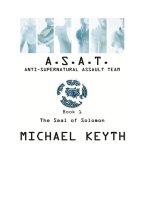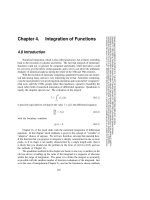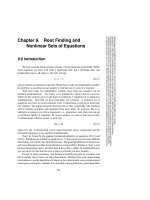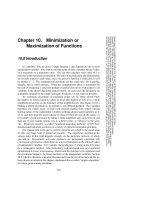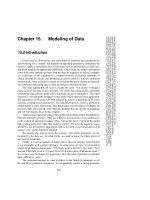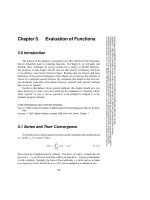ISO 295821:2009 Methods of testing cement — Determination of the heat of hydration — Part 1: Solution method
Bạn đang xem bản rút gọn của tài liệu. Xem và tải ngay bản đầy đủ của tài liệu tại đây (215.99 KB, 18 trang )
INTERNATIONAL ISO
STANDARD 29582-1
First edition
2009-07-15
Methods of testing cement —
Determination of the heat of hydration —
Part 1:
Solution method
Méthodes d'essai des ciments — Détermination de la chaleur
d'hydratation —
Partie 1: Méthode par dissolution
Reference number
ISO 29582-1:2009(E)
© ISO 2009
ISO 29582-1:2009(E)
PDF disclaimer
This PDF file may contain embedded typefaces. In accordance with Adobe's licensing policy, this file may be printed or viewed but
shall not be edited unless the typefaces which are embedded are licensed to and installed on the computer performing the editing. In
downloading this file, parties accept therein the responsibility of not infringing Adobe's licensing policy. The ISO Central Secretariat
accepts no liability in this area.
Adobe is a trademark of Adobe Systems Incorporated.
Details of the software products used to create this PDF file can be found in the General Info relative to the file; the PDF-creation
parameters were optimized for printing. Every care has been taken to ensure that the file is suitable for use by ISO member bodies. In
the unlikely event that a problem relating to it is found, please inform the Central Secretariat at the address given below.
COPYRIGHT PROTECTED DOCUMENT
© ISO 2009
All rights reserved. Unless otherwise specified, no part of this publication may be reproduced or utilized in any form or by any means,
electronic or mechanical, including photocopying and microfilm, without permission in writing from either ISO at the address below or
ISO's member body in the country of the requester.
ISO copyright office
Case postale 56 • CH-1211 Geneva 20
Tel. + 41 22 749 01 11
Fax + 41 22 749 09 47
Web www.iso.org
Published in Switzerland
ii © ISO 2009 – All rights reserved
ISO 29582-1:2009(E)
Contents Page
Foreword............................................................................................................................................................ iv
1 Scope ..................................................................................................................................................... 1
2 Normative references ........................................................................................................................... 1
3 Principle ................................................................................................................................................. 1
4 Reagents and materials ....................................................................................................................... 2
5 Apparatus .............................................................................................................................................. 2
6 Calorimeter calibration......................................................................................................................... 4
7 Determination of heat of solution ....................................................................................................... 6
8 Heat of hydration ................................................................................................................................ 10
9 Test report ........................................................................................................................................... 10
Bibliography ..................................................................................................................................................... 12
© ISO 2009 – All rights reserved iii
ISO 29582-1:2009(E)
Foreword
ISO (the International Organization for Standardization) is a worldwide federation of national standards bodies
(ISO member bodies). The work of preparing International Standards is normally carried out through ISO
technical committees. Each member body interested in a subject for which a technical committee has been
established has the right to be represented on that committee. International organizations, governmental and
non-governmental, in liaison with ISO, also take part in the work. ISO collaborates closely with the
International Electrotechnical Commission (IEC) on all matters of electrotechnical standardization.
International Standards are drafted in accordance with the rules given in the ISO/IEC Directives, Part 2.
The main task of technical committees is to prepare International Standards. Draft International Standards
adopted by the technical committees are circulated to the member bodies for voting. Publication as an
International Standard requires approval by at least 75 % of the member bodies casting a vote.
Attention is drawn to the possibility that some of the elements of this document may be the subject of patent
rights. ISO shall not be held responsible for identifying any or all such patent rights.
ISO 29582-1 was prepared by Technical Committee ISO/TC 74, Cement and lime.
ISO 29582 consists of the following parts, under the general title Methods of testing cement — Determination
of the heat of hydration:
⎯ Part 1: Solution method
⎯ Part 2: Semi-adiabatic method
iv © ISO 2009 – All rights reserved
INTERNATIONAL STANDARD ISO 29582-1:2009(E)
Methods of testing cement — Determination of the heat
of hydration —
Part 1:
Solution method
1 Scope
This part of ISO 29582 describes a method of determining the heat of hydration of cements by means of
solution calorimetry, also known as the solution method. The heat of hydration is expressed in joules per gram
of cement.
This part of ISO 29582 is applicable to cements and hydraulic binders, whatever their chemical composition.
NOTE 1 Another procedure, called the semi-adiabatic method, is described in ISO 29582-2. Either procedure can be
used independently.
NOTE 2 It has been demonstrated that the best correlation between the two methods is obtained at 7 d for the solution
method in this part of ISO 29582 compared with 41 h for the semi-adiabatic method in ISO 29582-2.
2 Normative references
The following referenced documents are indispensable for the application of this document. For dated
references, only the edition cited applies. For undated references, the latest edition of the referenced
document (including any amendments) applies.
EN 197-1, Cement — Part 1: Composition, specifications and conformity criteria for common cements
3 Principle
The method consists of measuring the heats of solution, in an acid mixture, of anhydrous cement and cement
hydrated under standardized conditions for a predetermined period of time, e.g. 7 days.
These standardized hydration conditions are as follows:
⎯ water/cement ratio of 0,40;
⎯ use of neat cement paste;
⎯ storage at a constant temperature of (20,0 ± 0,2) °C during the whole hydration process.
The heat of hydration for each period, Hi, is obtained from the difference between the heat of solution of
anhydrous cement, Qa, and that of hydrated cement, Qi.
© ISO 2009 – All rights reserved 1
ISO 29582-1:2009(E)
4 Reagents and materials
4.1 Acid mixture, analytical-reagent quality, obtained by adding 2,760 g of 40 % hydrofluoric acid (HF) per
100,0 g of (2,00 ± 0,01) mol/l nitric acid (HNO3), or 2,600 ml of hydrofluoric acid for every 100,0 ml of nitric
acid.
WARNING — Hydrofluoric acid can cause painful skin burns which heal only with difficulty and
precautions in handling this very corrosive substance should be strictly observed.
4.2 Acid mixture, proposed alternative, containing ammonium fluoride (NH4F) instead of hydrofluoric acid,
prepared as follows.
Place about 400 g of (2,00 ± 0,01) mol/l nitric acid and 7,2 g of ammonium fluoride in the flask. Then, add
(2,00 ± 0,01) mol/l nitric acid to make a total mass of 425,0 g ± 0,1 g. Any other procedure in the preparation
of acid mixture can be adopted, provided that the same mass ratio of nitric acid to ammonium fluoride is
conserved.
The quantity (mass or volume) of acid used, which is common to all tests, shall be measured to ± 0,2 %.
In the case of a dispute , only the reference acid mixture containing hydrofluoric acid is used.
4.3 Zinc oxide (ZnO), analytical quality, used to determine the thermal capacity of the calorimeter and
prepare as follows.
Weigh 40 g to 50 g. Ignite at (950 ± 25) °C for 1 h. Cool in a desiccator. Grind to pass a 125 µm sieve. Store
in a desiccator.
4.4 Anhydrous cement, from which metallic iron has been removed with a magnet, stored in a sealed
container to avoid absorption of water or carbon dioxide.
Bring the test sample to ambient temperature and carefully homogenize it before use.
4.5 Hydrated cement, test sample prepared as follows.
Vigorously mix, either manually or mechanically, (100,0 ± 0,1) g of anhydrous cement with (40,0 ± 0,1) g of
distilled or deionized water for 3 min at ambient temperature. Place the resulting paste in plastic or glass
cylindrical vials (three for each hydration period being tested) so that each vial contains 15 g to 20 g of
material. Seal the vials by means of a stopper and, if necessary, with paraffin wax or similar material and store
them horizontally in a thermostatic bath maintained at a temperature of (20,0 ± 0,2) °C.
5 Apparatus
5.1 Calorimeter, comprised of the following (see Figure 1).
NOTE The method does not deal with the standardization of the calorimetric apparatus, or the measuring instruments.
Insulated flasks with a volume of about 650 ml have proved to be suitable.
5.1.1 Dissolution vessel, consisting of an insulated flask (e.g. Dewar flask), placed either in a heat
insulated container set inside a box constructed of insulating material (e.g. wood, plastics), or immersed in a
thermostatic water bath regulated to ± 0,2 °C; and an insulated stopper (made of cork or plastic) through
which holes are provided for the thermometer, the stirrer and the funnel used for introducing the sample.
The insulation of the calorimeter shall ensure that the thermal leakage coefficient, K, (determined in
accordance with 6.3) is less than 0,06 K per 15 min for each kelvin above ambient temperature. The internal
surface of the flask, that part of the thermometer immersed in the acid mixture and the lower part of the
stopper, shall be acid-mixture-resistant.
2 © ISO 2009 – All rights reserved
ISO 29582-1:2009(E)
Key 7 support
8 flask support
1 stirrer motor 9 box
2 thermometer 10 stirrer
3 ambient thermometer 11 stopper
4 flask 12 funnel
5 insulating material
6 container
Figure 1 — Typical heat-of-solution calorimeter apparatus
5.1.2 Thermometer, either a Beckmann thermometer with a 5 °C to 6 °C scale and subdivisions every
0,01 °C, or other measurement apparatus of an equal or higher accuracy, such as a thermistor or platinum
resistance thermometer, positioned such that the end of the thermometer is at least 4 cm below the level of
the liquid surface.
Express temperature readings with a resolution of ± 0,002 °C. Adjust the zero of the Beckmann thermometer
so that the upper limit of the scale is approximately the ambient, or water bath, temperature. Calibrate the
thermometer in a thermostatic bath against a 0,01 °C graduated and calibrated thermometer.
© ISO 2009 – All rights reserved 3
ISO 29582-1:2009(E)
5.1.3 Funnel, of acid-mixture-resistant plastics, through which the sample is introduced into the flask and
which extends below the lower part of the stopper by 5 mm to 6 mm and is sealed during the test.
5.1.4 Stirrer, of acid-mixture-resistant plastics, positioned such that the blades are as close as possible to
the bottom of the flask and rotated by a motor at a speed of (450 ± 50) min −1. The motor shall have a low
power rating (e.g. a motor of a few watts) so as to prevent any excessive heat emission from affecting
measurements.
5.2 Thermostatic bath, e.g. water bath, for storing the hydrated samples at a temperature of
(20,0 ± 0,2) °C.
5.3 Mortar or electric grinder, for crushing the hydrated samples.
5.4 Plastic or glass vials, of capacity approximately 20 ml, for storing the hydrated paste.
5.5 Sieve, of mesh size 125 µm.
5.6 Sieve, of mesh size 600 µm.
5.7 Chronometer, graduated in seconds, for timing the temperature readings.
5.8 Two platinum crucibles, of capacity approximately 20 ml, for ignition of samples.
5.9 Electric furnace, naturally ventilated, capable of operating at (950 ± 25) °C, for ignition of samples.
5.10 Analytical balance, capable of weighing to an accuracy of ± 0,000 1 g.
5.11 Balance, of capacity 2 kg, capable of weighing to an accuracy of ± 0,2 g.
6 Calorimeter calibration
6.1 Principle
Calibration of the calorimeter is carried out in order to determine its thermal capacity and thermal leakage
coefficient. These characteristics are determined by dissolving the ignited zinc oxide (4.2) in the acid mixture
(4.1) and measuring the temperature of the calorimeter at fixed intervals of time. The temperature of the acid
mixture shall be so set that after the dissolution reaction, the calorimeter temperature is at least 0,5 °C below
the ambient temperature. Where a water bath is used, the temperature of the bath is considered to be the
ambient temperature for the calorimeter.
6.2 Procedure
Measure a quantity of acid mixture (4.1) by mass or volume to ± 0,2 % such that the liquid level is
approximately 2 cm below the calorimeter stopper. Place the acid mixture in the flask. Immediately before the
determination of the thermal capacity, ignite the zinc oxide at (950 ± 25) °C for a maximum of 5 min and cool
in a desiccator to room temperature. The mass of zinc oxide, mZnO, being used, weighed to ± 0,000 1 g, is that
required to satisfy Equation (1):
macid = 60 ± 1 (1)
mZnO
where macid is the mass of the acid mixture (4.1).
4 © ISO 2009 – All rights reserved
ISO 29582-1:2009(E)
Carry out the procedure as follows.
a) Preliminary period: Stir the acid mixture for 40 min to 50 min.
b) Pre-period: When the rate of temperature increase is constant, start the timing using the
chronometer (5.7) and record the initial temperature.
c) Sample introduction: After 15 min, record the temperature, T0, and immediately add the zinc oxide
sample to the acid mixture, taking not more than 1 min.
d) Dissolution period: Stir the mixture for 30 min, after which the dissolution is considered as being
complete, and then record the temperature, T30. Record the ambient
temperature, Ta. If the difference between Ta and T30 is less than 0,5 °C, then
repeat the test.
e) Post-period: Record the final temperature, T45 , after an additional 15 min.
In order to reduce reading errors, determine temperatures T−15, T30 and T45 as the average of five different
readings recorded at intervals of 1 min over the period 2 min before to 2 min after the prescribed time, Ti (i.e.
Ti−2, T i−1, Ti, T i+1, T i+2). Determine the value of T0 by extrapolation of the function of temperature against
time in the period T−4 to T−1. If the extrapolated value differs from the T0 reading by more than ± 0,002 °C,
then replace T0 by the extrapolated value. If more than a trace of zinc oxide is found adhering to the tip of the
funnel or to the stopper when the calorimeter is opened, repeat the calibration.
NOTE The temperature readings, therefore, effectively start 17 min before the zinc oxide sample is introduced and
the last reading takes place 47 min after its introduction. The total duration of the calibration is 64 min.
6.3 Calculation of calibration characteristics
6.3.1 Corrected temperature increase, ∆Tc
Calculate the corrected temperature increase, ∆Tc, expressed in kelvin, from Equation (2):
∆Tc = (T30 − T0 ) − 2 (T45 − T30 ) (2)
where T30 and T45 are the average values of five measurements made at intervals of 1 min.
6.3.2 Thermal leakage coefficient, K
Calculate the thermal leakage coefficient, K, in kelvin per 15 min per kelvin temperature difference,
(K/15 min⋅K−1), from Equation (3):
K = (T0 − T−15 ) − (T45 − T30 ) (3)
(T30 − T0 )
© ISO 2009 – All rights reserved 5
ISO 29582-1:2009(E)
6.3.3 Thermal capacity, c
Calculate the thermal capacity, c, expressed in joules per kelvin, from Equation (4):
c = mZnO [1 077,43 + 0,364 (30 − Tf ) + 0,50 (Ta − Tf )] (4)
∆ Tc
where
mZnO is the mass of zinc oxide, expressed in grams;
Tf
is the temperature at the end of the dissolution period, i.e. T30 + TBeck, where TBeck
corresponds to the zero on the Beckmann thermometer, with all temperatures expressed in
degrees Celsius;
Ta is the temperature (i.e. ambient temperature) of zinc oxide when introduced into the
calorimeter, expressed in degrees Celsius;
1 077,43 is the heat of solution of zinc oxide at 30 °C, expressed in joules per gram (J⋅g−1);
−0,364 is the temperature coefficient of the heat of solution of zinc oxide, expressed in joules per
gram per kelvin (J⋅g−1⋅K−1);
0,50 is the specific heat of zinc oxide, expressed in joules per gram per kelvin (J⋅g−1⋅K−1).
Calculate the thermal capacity, c, expressed to two decimal places, and the thermal leakage coefficient, K,
expressed to four decimal places, as the mean values of five calibrations of the calorimeter. If K is not less
than 0,06 K per 15 min per kelvin temperature difference, then the calorimeter does not meet the
requirements; see 5.1.1.
Calibration characteristics should be redetermined whenever
⎯ the thermometer has been recalibrated;
⎯ either the thermometer, the stirrer or the flask have been renewed or modified;
⎯ the operator considers that it is necessary.
7 Determination of heat of solution
7.1 Heat of solution of anhydrous cement
7.1.1 Procedure
Use acid mixture of the same composition, quantity and initial temperature as used for calibration of the
calorimeter; see 6.2. The quantity of the anhydrous cement sample, ma, weighed to ± 0,000 1 g, is the amount
required to satisfy Equation (5):
macid = 140 ± 2 (5)
ma
where macid is the mass of the acid mixture (4.1). After the preliminary stirring period of the acid mixture [see
6.2 a)], follow the procedures given in 7.1.1.1 applicable to all cements and hydraulic binders or 7.1.1.2
applicable only to Portland cements.
6 © ISO 2009 – All rights reserved
ISO 29582-1:2009(E)
7.1.1.1 Procedure applicable to all cements and hydraulic binders
Record the temperature, T−15 and start the chronometer. Record the temperature, T0, after 15 min and
immediately introduce the sample, taking not more than 1 min. Record the temperature, T30, after a
dissolution period of 30 min.
Follow the procedure for reading the temperature given in 6.2 for the anhydrous sample, to avoid reading
errors.
7.1.1.2 Portland cement
This is designated CEM I in accordance with EN 197-1.
Record the temperature, T0, start the chronometer and immediately introduce the sample, taking not more
than 1 min. After a dissolution period of 30 min, record the temperature, T30. After a further post-period of
15 min record the temperature, T45.
Follow the procedure for reading the temperature given in 6.2 for the anhydrous sample, to avoid reading
errors.
7.1.2 Calculation
7.1.2.1 Corrected temperature increase
On the basis of the temperature readings taken in accordance with 7.1.1.1 or 7.1.1.2, calculate ∆Tc from
Equation (6), for all cements and hydraulic binders, or Equation (7), for portland cements (CEM I):
∆Tc = (T30 − T0 ) − 2 ⎡⎣(T0 − T−15 ) − K(T30 − T0 )⎤⎦ (6)
where K is the thermal leakage coefficient, expressed in kelvin per 15 min per kelvin temperature difference,
(K/15 min·K−1).
∆Tc = (T30 − T0 ) − 2(T45 − T30 ) (7)
7.1.2.2 Heat of solution
Calculate the heat of solution of anhydrous cement, Qa, expressed in joules per gram, from Equation (8):
Qa = c ⋅ ∆Tc + 0,8 (Tf − Ta ) + 0,8 (Tf − 20) (8)
ma
where is the corrected temperature increase, expressed in kelvins;
∆Tc is the thermal capacity of the calorimeter, expressed in joules per kelvin (J⋅K−1);
c
ma is the mass of anhydrous cement, expressed in grams;
Tf is the temperature at the end of the anhydrous cement dissolution period, expressed in degrees
Celsius;
Ta is the temperature of the anhydrous cement (i.e. ambient temperature) when introduced into the
calorimeter, expressed in degrees Celsius;
0,8 is the specific heat of the anhydrous cement, expressed in joules per gram per kelvin (J⋅g−1⋅K−1);
−0,8 is the temperature coefficient of the heat of solution of the anhydrous cement, expressed in joules
per gram per kelvin (J⋅g−1⋅K−1).
© ISO 2009 – All rights reserved 7
ISO 29582-1:2009(E)
NOTE The last term in the equation is introduced so as to correct the value of the heat of solution for any divergence
from the reference temperature, 20 °C.
7.1.3 Expression of results
Express the heat of solution of the anhydrous cement, Qa, as the mean of two measurements, expressed to
one decimal place. If the difference between the two measurements is greater than 14 J⋅g−1, carry out a third
test. Reject any result that differs from the mean of these three values by more than ± 7 J⋅g−1. If one result is
rejected, calculate the mean from the remaining two values.
The standard deviation of repeatability, σr, for the measurement of heat of solution of anhydrous cement is
5 J⋅g−1. Therefore, the results of two properly conducted tests by the same operator on samples of the same
cement should not differ from each other by more than 14 J⋅g−1.
7.2 Heat of solution of hydrated cement
7.2.1 Procedure
Remove the sample of hydrated cement (4.5) from the vial and crush quickly, so that the whole sample
passes the 600 µm sieve (5.6). When crushing by means of a rapid crusher, operate this for (45 ± 15) s.
Complete the reduction in not more than 15 min to minimize contact with air and avoid carbon dioxide
absorption. Alternatively, these procedures can be undertaken in a nitrogen atmosphere in a glove box.
Place the sample in a sealed container and homogenize by shaking, either manually or mechanically. Weigh
the three samples from the same vial required for the calorimetric determination and determination of
bound-water correction, in quick sequence to avoid water loss or carbon dioxide absorption. Increase the
quantity of the hydrated sample used to determine the heat of solution by 40 % over that used to test the
anhydrous sample. Weigh the hydrated sample to ± 0,000 1 g. Carry out the calorimetric determination as for
the anhydrous cement (see 7.1.1).
Commence the heat-of-solution determination within the following times according to the specified hydration
age:
a) ± 30 min for hydration ages less than 3 d1);
b) ± 1 h for hydration ages greater than or equal to 3 d and less than 7 d;
c) ± 2 h for hydration ages greater than or equal to 7 d.
7.2.2 Correction for bound water
Correct the mass of the hydrated sample to its anhydrous mass by determining the bound water by igniting
portions of the same sample of the anhydrous cement and a sample of hydrated cement from a vial, as used
for the calorimetric determination. Weigh two 2 g samples to ± 0,000 1 g. Ignite using platinum crucibles, at
(950 ± 25) °C for 1 h, then cool in a desiccator to ambient temperature and weigh immediately.
The maximum deviation between the two determinations of percentage mass change on ignition for either the
anhydrous, ma, or hydrated, mh, cement shall not be greater than 0,1 %.
Alternative instrumental methods, such as thermogravimetry or automatic water and carbon dioxide analysers,
may be used for this determination.
1) In the case of time inconsistency when using a single calorimeter, it is necessary to use a sample of hydrated cement
taken from two separate mixes made at different times.
8 © ISO 2009 – All rights reserved
ISO 29582-1:2009(E)
The bound water correction may be determined from the calcium oxide (CaO) content by chemical analysis or
X-ray fluorescence, instead of by ignition. The calcium oxide determination requires greater accuracy, as an
error in the calcium oxide content affects the heat of hydration by a factor of two, compared with the
percentage mass change on ignition method.
If the cement contains oxidizable components, then the determination by calcium oxide content should be
used.
7.2.3 Calculation
7.2.3.1 Calculate the corrected temperature increase, ∆Tc, from Equations (6) and (7) for the hydrated
cement.
7.2.3.2 Calculate the heat of solution, Qi, expressed in joules per gram of hydrated cement, from
Equation (9):
Qi = c ⋅ ∆Tc + 1,7 (Tf − Ta ) + 1,3 (Tf − 20) (9)
mh ⋅ F
where
mh is the mass of hydrated cement, expressed in grams;
Tf is the temperature at the end of the dissolution period of the hydrated sample, expressed in
degrees Celsius;
Ta is the temperature of the hydrated cement (i.e. ambient temperature) when introduced into the
calorimeter, expressed in degrees Celsius;
F is the correction factor for bound water;
1,7 is the specific heat of hydrated cement, expressed in joules per gram per kelvin (J⋅g−1⋅K−1);
−1,3 is the temperature coefficient of the heat of solution of hydrated cement, expressed in joules per
gram per kelvin (J⋅g−1⋅K−1).
Calculate the correction factor, F, for bound water from Equation (10), based on ignition, or Equation (11),
based on the lime content:
F = 100 − ∆mh (10)
100 − ∆ma
where
∆mh is the mass change on ignition of the hydrated sample, expressed in percent by mass;
∆ma is the mass change on ignition of the anhydrous sample, expressed in percent by mass.
F = wh (11)
wa
where
wh is the calcium oxide content of the hydrated sample, expressed in percentage mass fraction;
wa is the calcium oxide content of the anhydrous sample, expressed in percentage mass fraction.
© ISO 2009 – All rights reserved 9
ISO 29582-1:2009(E)
7.2.4 Expression of results
Express the heat of solution of the hydrated sample, Qi, as the mean of two measurements, expressed to
one decimal place. For each measurement, use a new sample, taken from a different vial of the same set
(see 4.5).
NOTE The precision and acceptance limits for results of determination of heat of solution of the hydrated sample are
the same as those given for anhydrous cement; see 7.1.3.
8 Heat of hydration
8.1 Calculation of results
Calculate the heat of hydration of cement, Hi, expressed in joules per gram and referenced to 20 °C, as the
difference between the heat of solution of anhydrous and hydrated cement obtained in accordance with 7.1.2
and 7.2.3 from Equation (12):
H i = Qa − Qi (12)
8.2 Reporting of results
Report the results for the heat of hydration, Hi, expressed in joules per gram of cement, to the nearest whole
number.
8.3 Precision
8.3.1 Repeatability
The standard deviation of repeatability, σr, of the heat of hydration is 8 J⋅g−1.
Therefore, if the results of two properly conducted tests from the same laboratory on samples of the same
cement are compared, they should not differ from each other by more than 22 J⋅g−1.
8.3.2 Reproducibility
The standard deviation of reproducibility, σR, is 18 J⋅g−1.
Therefore, if the results of two properly conducted tests from two different laboratories on samples of the
same cement are compared, they should not differ from each other by more than 50 J⋅g−1.
9 Test report
9.1 The test report shall include the following:
a) identification of the test specimen;
b) date of test;
c) heat of solution of the hydrated sample, Hi, expressed in joules per gram of cement, to the nearest whole
number;
d) any deviations from the standard method of testing;
e) declaration from the person technically responsible for the test that the testing was carried out in
accordance with this part of ISO 29582, except as detailed in item d).
10 © ISO 2009 – All rights reserved
ISO 29582-1:2009(E)
9.2 The report may include the following:
a) mass of the specimen;
b) condition of the specimen on receipt.
© ISO 2009 – All rights reserved 11
ISO 29582-1:2009(E)
Bibliography
[1] ISO 29582-2, Methods of testing cement — Determination of the heat of hydration — Part 2:
Semi-adiabatic method
12 © ISO 2009 – All rights reserved
ISO 29582-1:2009(E)
ICS 91.100.10
Price based on 12 pages
© ISO 2009 – All rights reserved
